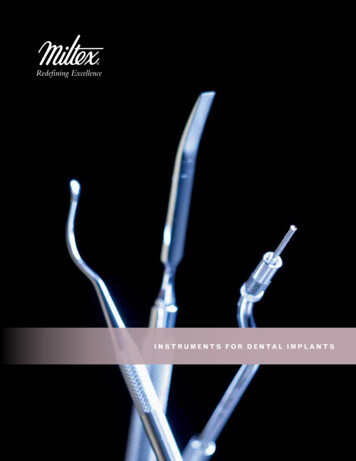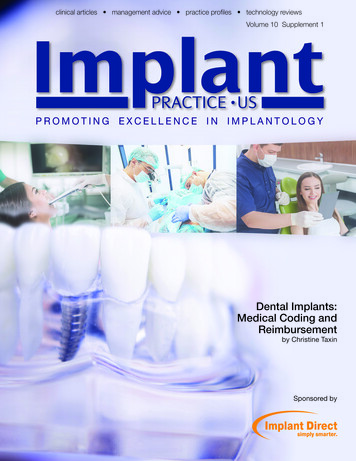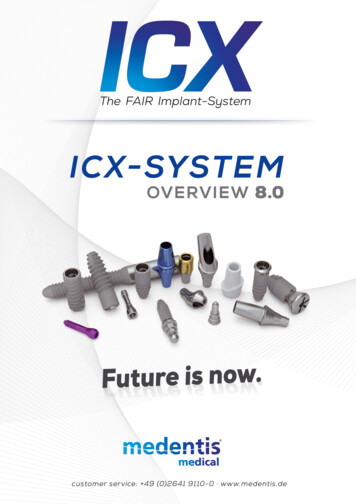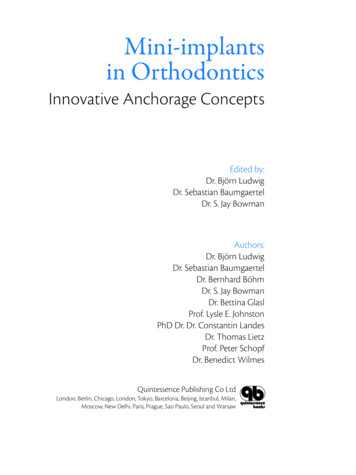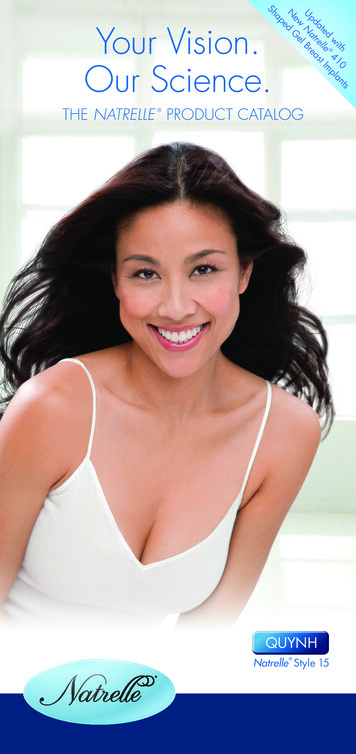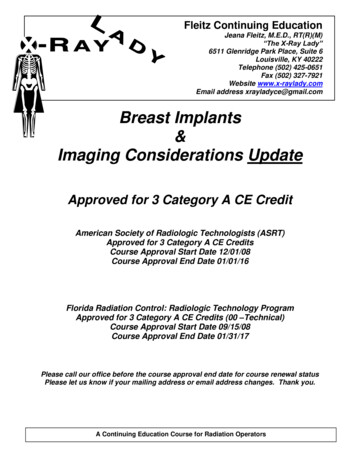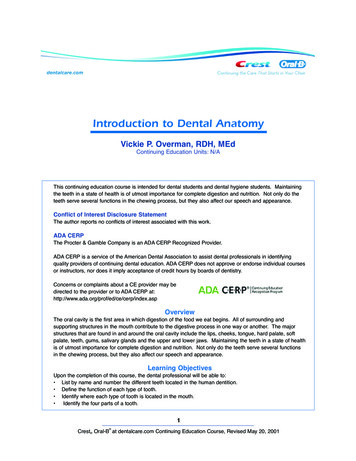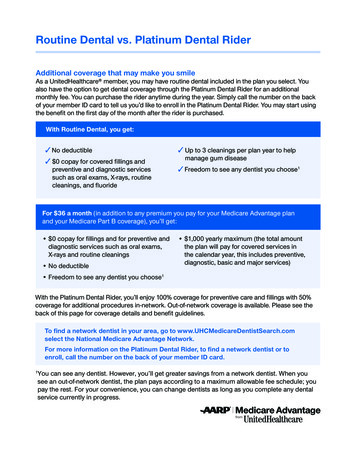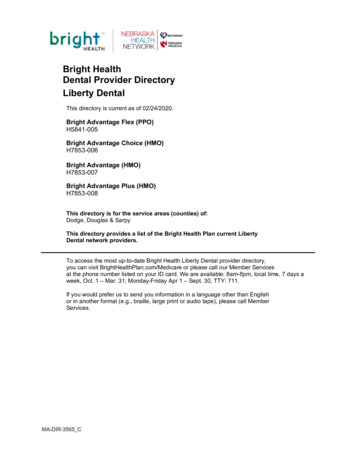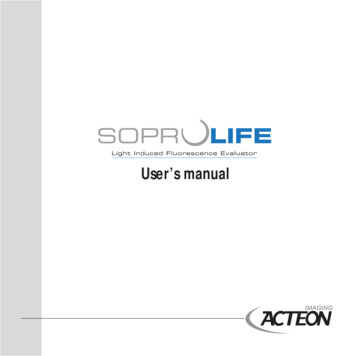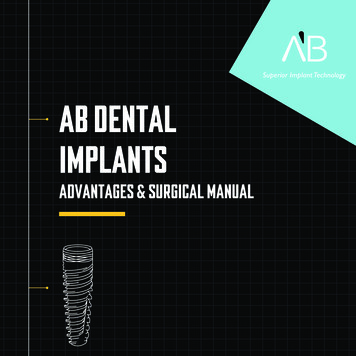
Transcription
1AB DENTALIMPLANTSADVANTAGES & SURGICAL MANUAL
23End-to-endimplant solutionsAB Dental is an international, dynamic, innovative company,providing the dentist a complete solution for all dental implantsneeds.AB Dental offers a wide range of implants, prosthetic products,tools, accessories and CAD/CAM solutions, required for the dentistto perform an accurate and successful treatment.AB Dental is committed to its customers satisfaction andguarantees long term success using its Implants, based on thehighest international standards, the strictest quality controlmeasures and more than 10 years of follow-up. AB Dental'simplants were found to have excellent results of durability andsafety in a recent report that was received as part of the company'sPMCF (Post-Market Clinical Follow-up) study.This booklet will present AB Dental's various implants and theirunique design, characteristics, advantages and indications, tomeet the needs of each dentist and patient.
45CONTENTAB DENTAL A COMPLETEIMPLANT SOLUTIONAB DENTAL - A COMPLETE IMPLANT SOLUTION5MATERIAL6BIOLOGICAL SURFACE6ABGUIDEDSERVICE7IMPLANT PACKAGE CONTENT8IMPLANTATION PROTOCOL9BASIC IMPLANTOLOGY STEP BY STEP10DRILLING PROTOCOL12BONE DENSITY TYPE 114BONE DENSITY TYPE 215BONE DENSITY TYPE 3/416IMPLANT DEPTH18IMPLANT TYPES19CHOOSING THE PROPER IMPLANT20AB DENTAL IMPLANTS21AB DENTAL OFFERS A UNIQUE MODEL TO THE MARKET WHICH PROVIDES THE DENTIST WITH ACOMPLETE SOLUTION A wide range of implants, prosthetic products, tools, accessories and CAD/CAM solutions requiredfor the dentist to perform an accurate and successful treatment. Computerized implant planning. 3D printing of surgical guides. Custom individual implants using laser-sintering technology. In-house training center fully equipped for lectures and hands-on trainings and webinars for ourcustomers all over the world.WITH A MISSION TO LEAD THE MARKET WITH THE NEXT GENERATION OF SMART DENTALTECHNOLOGY AND SOLUTIONS, WE PROVIDE MORE THAN JUST SERVICES - WE HOLD OURSELVESTO THE HIGHEST STANDARDS OF CARE.We believe that the human resource is one of the most important resources of a company, it is thebasis of good relationship with our customers. Good service must start from within the company,throughout all company levels, in order to give the best service to our customers.AB Dental adheres to the highest international standards and has obtained approvals from regulatoryagencies in multiple countries: FDA (USA), CE (Europe), Russia Federation, AMAR (Israel), ChineseFDA, India FDA, Taiwan FDA, Australian TGA, Ukraine and more.
6MATERIALAll AB Dental implants are made of Titanium alloy Ti-6Al-4V ELI in accordance withASTM-F136-02 standard specification.Titanium alloy is a proven ideal implant material: Able to integrate almost completely with the bone. Bio-friendly. Provides favorable mechanical qualities (strength, endurance). Can be precisely fabricated (precision measured in microns) to ensure a range of implants that meet therequirements for optimizing stability in the widest range of patients (considering the dimensions and state ofhealth of an individuals’ bone and gums).BIOLOGICAL SURFACEAB Dental implants undergo a special treatment of Biological blasting with Calcium Phosphate for surfaceroughening, to enhance the direct attachment of the bone to the implant (Osseointegration), to remove harmfulaluminum remnants and achieve clean implant surface.Next, the implants undergo SLA (sandblasted with large-grits, acid-etched) treatment, and lastly, they aresterilized by Gamma irradiation.7guidedserviceTHE ULTIMATE GUIDE FOR PRECISE IMPLANTATIONSABGUIDEDSERVICE will give you anything you need for implantation in one package with one click: Preparation of a treatment plan according to your instructions. 2D and 3D images of the plan in ABDenpax web-based technology. Digital production of a surgical guide, directly from the planning software. A complete color-coded drill kit that provides all the tools you'll need, with no measurements needed during surgery.9 Reasons Why ABGUIDEDSERVICE Maximum accuracy Relating to prosthetics All calculations and measurements before surgery Flapless in many cases Minimally invasive Can save bone augmentation and sinus lift Angled implants Surgery takes less time Abutments and healing caps planned
89IMPLANT PACKAGE CONTENTIMPLANTATION PROTOCOLBone level implants:PACKAGE CONTENTMaintain the sterility of the implant after removing the implant from its double wrapping.The implant should be screwed manually via the carrier.Extract the carrier and follow insertion of the implant inside the osteotomy by implant drivers tools as required.Take the implant out of the package using a gripping implant driver and screw the implant inside the osteotomy asrequired.AB Dental Implants can be provided in a package with or without an implant carrier.WITH CARRIERWITHOUT CARRIERClip carrierColor coded tubecap indicates thefinal drill color.T5Cover screwImplantImplantExternal TubeInternal TubeComponentsInternal TubeThe Implants are available with / without carrier:ComponentsColor-coded tube caps indicate thefinal drill color:One-piece implants:PACKAGE CONTENTIntegral implant carrierFinal drillsize2.02.8Color coded tubecap indicates thefinal drill color.3.23.65Implant4.04.55.0Internal tube For dentists who prefer the manual feel of the torque.Implants without carrierTube topcap colorsExternal tubeImplants with carrierComponents5.5 For dentists who prefer not to touch the implant forhygienic reasons or would rather depend on the contraangle's torque.
1011BASIC IMPLANTOLOGYSTEP BY STEPGENERAL RECOMENDED DRILLING PROCEDURE FOR ALL IMPLANTSAfter gathering all needed medical and dental information, reaching a diagnosis, in conjunction with X-rays and/or CTscan, assuring that the patient is suitable for an implant-based rehabilitation per your best professional discretion anddetermining a treatment plan approved by the patient - continue to the next step: implantation.Surgically expose the bony surface.Determine the position for the implant placement.Using our marking drill make a marking guide hole, down into the cortical bone to the level of the neck beneath the drillcutting head. Do not attempt to drill deeper with the marking drill.Using the guide hole for position, the color-coded drill will be utilized to drill the osteotomy to the desired depth. The colorcoding on the drills indicates their diameter.The drill protocol for all implant start with Ø2.0 mm drill. In case preferred, for small diameter implant smaller diameterdrills can be used.The drills are used in graduated order to slowly increase the diameter of the osteotomy until the desired diameter isreached. This will allow safe progression and decrease trauma to the surrounding bony structures.The accurate depth of the osteotomy is determined by the length of each particular implant and is indicated by the depthlines around each drill, in order to allow good position of the implant in the bone so that its proximal end is flush with thealveolar ridge.Final drill color (for hard bone) should correspond to Implant's Tube Cap color.Note: Do not insert an implant with a carrierall the way to the final depth, but to 2/3 ofthe depth, and then continue manually with aratchet.
1213DRILLING PROTOCOLOPTIONAL DRILLSRECOMMENDED STRAIGHT DRILL PROTOCOLDrill Diameter (mm)Drill Speed (RPM)TMDTPDTDTDTDTDTDTDTDTDØ 1.9Ø2Ø 2.5Ø 2.8Ø 3.2Ø 3.65Ø 4.0Ø 4.5Ø 5.0Ø ONAL DRILLSRECOMMENDED CONICAL STOPPER DRILL PROTOCOLTDSØ1.2TDSØ1.5Drill Diameter (mm)Drill Speed (RPM)TMDTDCStTDCStTDCStTDCStTDCStTDCStØ 1.9Ø 2.2Ø 2.7Ø 3.3Ø 3.7Ø 4.0Ø 0-500TMD Marker drill bitTMD Marker drill bitTPD Pilot drill bitTDCSt Conical Stopper drillTDCS3.75-4.2TDCS5-6TDSØ1.2TDSØ1.5TD Straight drill bitProcedure recommended by AB Dental should notreplace the dentist/surgeon’s judgment and experience.Final drill color (for hard bone) should correspond toImplant’s Tube Cap colorImplantDiameterBoneTypeØ2.4Soft BoneHard BoneØ3Soft BoneHard BoneØ3.3Soft BoneHard BoneØ3.5Soft BoneHard BoneØ3.75Soft BoneHard BoneØ4.2Soft BoneHard BoneØ4.5Soft BoneHard BoneØ5Soft BoneHard BoneØ6Soft BoneHard BoneImplantDiameterSoft BoneHard BoneØ3Soft BoneHard BoneØ3.3Soft BoneHard BoneØ3.5Soft BoneHard BoneØ3.75Soft BoneHard BoneØ4.2Soft BoneHard BoneØ4.5Soft BoneHard BoneØ5Soft BoneHard OptionalOptionalOptionalMark drill siteDrill throughout entire implant’s lengthDrill through cortical plate in case neededcProcedure recommended by AB Dental should notreplace the dentist/surgeon’s judgment and experience.Final drill color (for hard bone) should correspond toImplant’s Tube Cap colorDrill through cortical plate with a countersink drill in case neededOptionalOptionalOptionalcOptionalOptionalc16 mm13 mm11.5 mm10 mm8 mm6 mmMark drill siteDrill throughout entire implant’s lengthc
14BONE DENSITYTYPE 1 Dense trabeculae. Sparse blood supply. Risk of breaking and heating.15Note: For all bone types:It is recommended to insert the implant into thetrabecular bone, and not the cortical bone, inorder to avoid interruption of blood supply.BONE DENSITYTYPE 2 Ideal for implant placement. Drilling can be performed continuously.Attention: Drilling in type 1 bone should be performed gradually, not continuously, to prevent: Bone over-heating. Trabeculae destruction. Implant failure.Drill with up-and-down movements to the required length, staying no more than 4 seconds in the osteotomy each drilling.1. Start with TMD-1.9 Marker Drill Bit to mark the implant placement, to a depth of 2mm.2. Continue drilling with TPDD-2.0 Pilot Coated Drill Bit up to the required length.3. Continue drilling with TDD-2.8 Coated Drill Bit to the required length, and then continuethe drilling sequence according to the intended implant's diameter.4. The recommended final drill should be 0.5mm less than theimplant's diameter.1. Start with TMD-1.9 Marker Drill Bit to mark the implant placement, to a depth of 2mm.2. Continue drilling gradually with up-and-down movements with TPDD-2.0 Pilot Coated Drill Bit up to the required length.3. Continue drilling gradually with up-and-down movements with TDD-2.8 Coated Drill Bit to the required length, and thencontinue the drilling sequence according to the intended implant's diameter.4. The recommended final drill shouldbe 0.1mm shorter than the implant's diameter.5. Recommended: countersink drill to avoid cervicalabsorption and to allow easy insertion of the implantwithout pressure.6. Insertion of the implant with two steps forward one step back, to allow better blood supply to thebone around the implants.Recommended implant type: gentle threaded - i2, i22.Recommended implant type: gentle threaded - i2, i22.
16BONE DENSITYTYPE 3/4 Spacious trabeculae. Soft bone – respect it! Drilling can be performed continuously. The recommended implant is one with sharp and deep threads – I5, I55.1. Start with TMD-1.9 Marker Drill Bit to mark the implant placement, to a depth of 2mm.2. Continue drilling with TPDD-2.0 Pilot Coated Drill Bit up to the required length.3. Continue drilling with TDD-2.8 Coated Drill Bit to the required length, and then continue the drilling sequence according tothe intended implant's diameter.4. The recommended final drill should be 1mm less than the implant's diameter.Recommended implant type: sharp and aggressive threaded - i5, i55.17
1819Implant depthIMPLANT TYPESThe recommended position for perfect restoration is achieved by reaching bone level, which is the exact height, with one ofthe hexagon's faces tangential to the external jaw arc. Implant drivers assist the visualization of the Hexagon faces.Integrated implant and abutment (one-piece): Require immediate loading and rehabilitation Require cementing of the restoration device (not screw-retained) No choice as to the structure of the abutment. That choice is made beforehand. One-piece implants are not suitable incase the restoration needed cannot be parallel to the implantRemove the cover screw or healing cap prior to restoration in two-piece implants.Complete the screwing motion with a torque of up to 45 Ncm, up to initial stability.The implant should be implanted in tubercular bone, to avoid heating the bone and future absorptions.If you intend to load the implant immediately - tighten the abutment with a torque of 35 Ncm, to check whether the implantis resistant to loading.Note: Do not exceed 30 Ncm when using theimplant carrier to insert the implant!One can close the implant top with a coverscrew, stitch, and wait for recovery, or loadimmediately by installing the proper abutment,and stitch tissue around.Two-piece implants: Offer the greatest range of rehabilitation options Allow immediate immediate loading or two-stage restoration The restoration can be cemented or screwed Angular implants can be restoredIf there is a need for immediate loading, the conical implant, which has good retention from the outset, should be usedIn single-rooted teeth and in the upper teeth between tooth 4 and tooth 7, where the sinus cavity is found, wide conicalimplants are recommended in order to reduce pressure on the base of the sinus.When the bone is very wide, and the sinus cavity is distant, any implant can be used.When the bone is narrow, a wide implant should not be used.
20CHOOSING THEPROPER IMPLANT21IMPORTANT:The operator must be a licensed dentist,trained and certified to preform dentalimplants.The information written in this booklet isgeneral guidelines, and should not replace thedentist/surgeon's judgement and experience.AB DENTALIMPLANTSThe implant size (height and width) is chosen according to preliminary X-rays.After making a preliminary diagnosis, an X-ray and/or CT should be used to determine the dimensions of theimplant suitable for the site in question. Alternatively, use ABGuidedService to accurately plan and preform theimplant treatment.There must be a 2 mm margin from anatomical obstacles and maximum bone height.The implant type should be chosen according to the type and amount of bone it is intended for.The dimensions of the implant should be chosen according to the height and width of the bone, and the interdental space it is intended for.As a general rule, the widest and longest implant suitable for a particular site (density and dimensions of bone,dimensions of gums) should be used, in order for rehabilitation to be most effective.Another general rule is that implant and abutment combinations offer the greatest range of rehabilitationoptions.I2Screw TypeImplantI22Screw pezeImplantI6NarrowIntegralImplantI6bOne Piece BallAttachmentImplantI7IntegralImplant
2223i2 Screw type implantPlatformL (mm)I23.5Standard8, 10, 11.5, 13, 16BothI23.75Standard8, 10, 11.5, 13, 16BothI24.2Standard8, 10, 11.5, 13, 16BothI25Standard8, 10, 11.5, 13, 16BothI26Standard8, 10, 11.5WithParallel implant with slight convergence in the apical zone, gentle threads for maximal confidence.UNIQUE CLINICAL BENEFITS Prevents cervical bone resorption due to delicate threading. Long term stability.RECOMMENDED BONE TYPESType 1-2 lower jawRANGE Standard platform. With carrier.FINAL DRILL0.1 mm shorter than the implant's diameter.DRECOMMENDED DRILL PROTOCOLDrill Diameter (mm)Drill Speed (RPM)ImplantDiameterLWith/WithoutImplant carrierD(mm)WHY I2 IMPLANT?UNIQUE DESIGN Parallel implant with slight convergence in the apical zoneof 3 degrees, which provides easier implant insertion. Double gentle threads with distance of 0.6 mm whichprovide a greater initial stability. Cutting dense threads at the apex for easier penetration. Double platform for wide restoration possibilities. Groovy neck - for increased osseointegration at the implantneck area.Tube top capcolorsCATno.TPDTDTDTDTDTDTDTDTDØ2Ø 2.5Ø 2.8Ø 3.2Ø 3.65Ø 4.0Ø 4.5Ø 5.0Ø 00-600300-500200-400200-400BoneTypeØ3.5Soft BoneHard BoneØ3.75Soft BoneHard BoneØ4.2Soft BoneHard BoneØ5Soft BoneHard BoneØ6Soft BoneHard BonecTMDØ lcOptionalOptionalMark drill siteDrill throughout entire implant’s lengthTMD Marker drill bitDrill through cortical plate in case neededTPD Pilot drill bitDrill through cortical plate with a countersink drill in case neededTD Straight drill bitc
24i22 Screw type implant25Tube topcap colorsWith/WithoutImplant carrierCATno.D(mm)PlatformL (mm)I223.75Standard8, 10, 11.5, 13, 16BothI224.2Standard8, 10, 11.5, 13, 16BothI225Standard8, 10, 11.5BothWHY i22 IMPLANT?Conical implant with gentle threads for maximal confidence.RECOMMENDED DRILL PROTOCOLUNIQUE DESIGN Conical implant. Gentle threads. Triple lead threads with distance of 0.9 between one and the other. Double thread at the apex that provides better initial stability. Double platform for wide restoration possibilities. Groovy neck - for increased osseointegration at the implant neckarea.UNIQUE CLINICAL BENEFITS Triple lead for achieving intimate bone contact and shorterinsertion time. Allows initial stability for immediate loading. Switch and double platform. Minimum pressure for type 1 bone. High degree of bone-to-implant contact (BIC).DDrill Diameter (mm)Drill Speed (RPM)ImplantDiameterSoft BoneHard BoneØ4.2Soft BoneHard BoneØ5Soft BoneHard BoneRECOMMENDED BONE TYPEType 1-2 lower jaw.RANGE Standard platform. Length: 8, 10, 11.5, 13, 16mm. Diameter: 3.75, 4.2, 5mm. With and without carrier.FINAL DRILL0.1 mm shorter than the implant's diameter.cTPDTDTDTDTDTDTDØ2Ø 2.5Ø 2.8Ø 3.2Ø 3.65Ø 4.0Ø 00-600300-500BoneTypeØ3.75LTMDØ lcMark drill siteDrill throughout entire implant’s lengthTMD Marker drill bitDrill through cortical plate in case neededTPD Pilot drill bitDrill through cortical plate with a countersink drill in case neededTD Straight drill bit
2627i5 CONICAL IMPLANTCATno.D(mm)PlatformL (mm)I5/I6BI3Narrow10, 11.5, 13, 16BothI53.2/3.3Narrow10, 11.5, 13, 16BothI53.5Standard10, 11.5, 13, 16BothI53.75Standard8, 10, 11.5, 13, 16BothI54.2Standard8, 10, 11.5, 13, 16BothI54.5Standard6, 8, 10, 11.5, 13, 16BothSpiral implant with sharp and deep threads.I55Standard6, 8, 10, 11.5, 13, 16BothBone spreading implant. Self-Tapping. High initial stability. Long term survivability.I56Standard6, 8, 10, 11.5, 13, 16WithWHY i5 IMPLANT?DUNIQUE CLINICAL BENEFITS Available in narrow diameter for narrow ridge. Suitable for immediate extraction and implantation. Double platform. Switch platform. Minimum drilling. Aggressive threads at the apex for initial stability.ImplantDiameterLRECOMMENDED BONE TYPEType 3-4 upper jawRANGEStandard & narrow platform.FINAL DRILL0.1 mm shorter than the implant's diameter.Conical drill recommended.With/WithoutImplant carrierRECOMMENDED DRILL PROTOCOLDrill Diameter (mm)Drill Speed (RPM)UNIQUE DESIGN Spiral implant with sharp threads. Variable thread design, from sharp to wide, to achieve bonecompression and stability. Groovy neck. A narrow apex for better primary stability and long term survivability. Double platform for wide restoration possibilities.Tube top capcolorsTMDTPDTDTDTDTDTDTDTDTDØ 1.9Ø2Ø 2.5Ø 2.8Ø 3.2Ø 3.65Ø 4.0Ø 4.5Ø 5.0Ø 00-600300-500200-400200-400BoneTypeØ3Soft BoneHard BoneØ3.3Soft BoneHard BoneØ3.5Soft BoneHard BoneØ3.75Soft BoneHard BoneØ4.2Soft BoneHard BoneØ4.5Soft BoneHard BoneØ5Soft BoneHard BoneØ6Soft BoneHard BoneOptionalOptionalOptionalMark drill siteDrill throughout entire implant’s lengthDrill through cortical plate in case neededcDrill through cortical plate with a countersink drill in case neededOptionalOptionalOptionalOptionalOptio
AB Dental is an international, dynamic, innovative company, providing the dentist a complete solution for all dental implants needs. AB Dental offers a wide range of implants, prosthetic products, tools, accessories and CAD/CAM solutions, required for the dentist to
